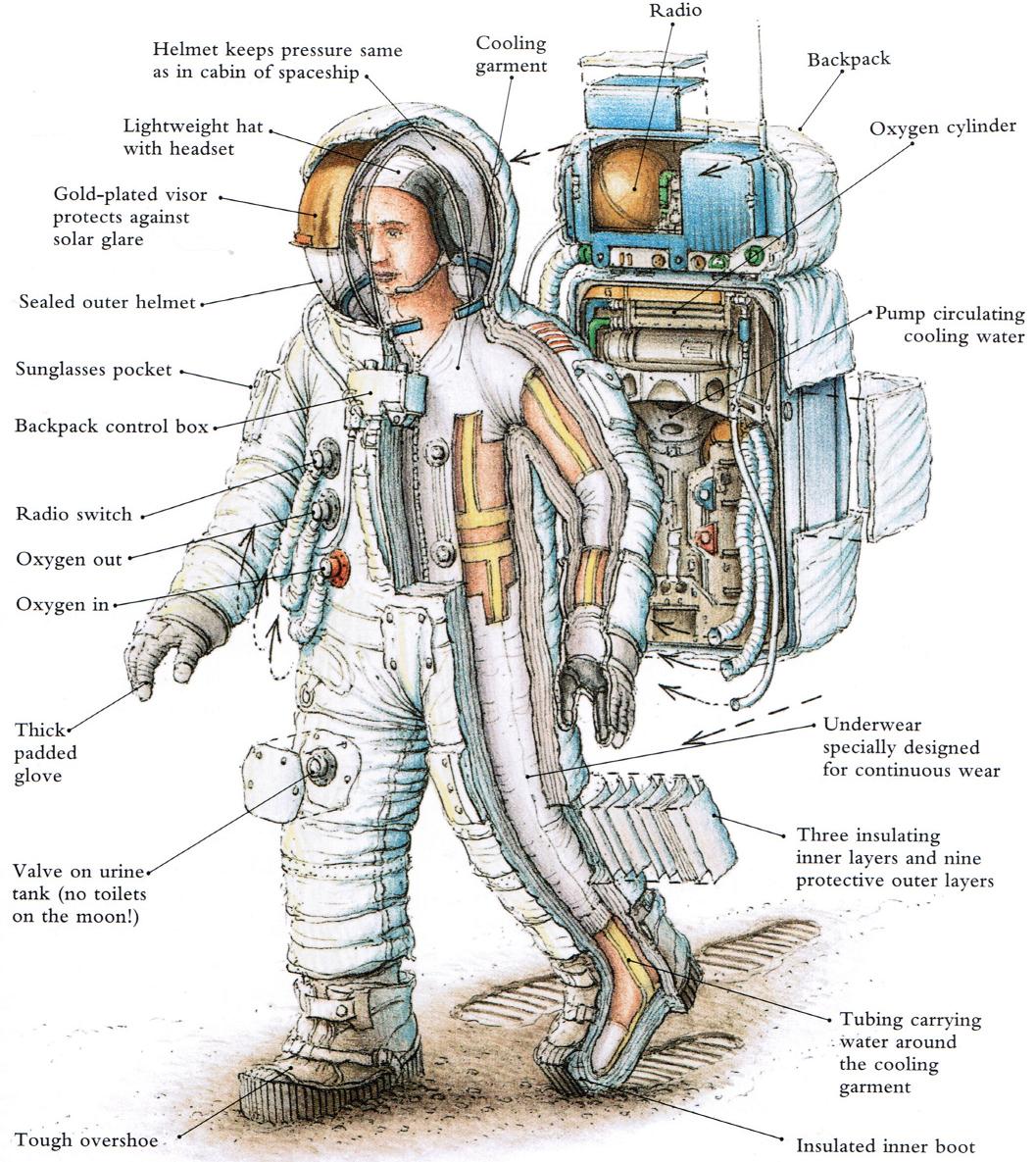|
|
Post by brotherofthemoon on Feb 19, 2012 22:10:49 GMT -4
Was in the library yesterday when I stumbled across a fairly new book titled Into The Unknown: How Great Explorers Found Their Way by Land, Sea, and Air by Stewart Ross, and illustrated by Stephen Biesty. The last chapter is about Apollo 11, and features some nifty gatefold artwork showing cutaways of the LM, CM, and Saturn V, and a 22 x 11 inch poster depicting each step of the mission. Unfortunately, this bit of the book is riddled with errors that the book's target audience will probably miss. Here's some I noticed: The service module carried "food and water for three weeks." The VAB "had its own weather inside -including clouds." Apollo 8 flew around behind the moon, giving it's crew "a view of the dark side." The Apollo 10 LM was not fitted with landing gear, so the crew "were not tempted to go any further." SWC described as "checking for lunar wind." CM described as 18 feet in diameter. There's a couple of bits of space jargon that have been dumbed down for the third-grade crowd, but I'm not sure how those gaffes got in there. Still, the rest of the book is nicely done - lots of detailed cutaways and maps, including the Trieste, Piccard's gondola, David Livingstone's Ma Roberts, and the HMS Endeavour, just to name a few. I just hoped the Apollo 11 part would stand up to closer scrutiny. Poor Stephen Biesty couldn't resist drawing a crater under the LM; not a giant, charred crater, but still a crater nonetheless. At least he got the size of the S-IC's LOX tank right this time! Here's Biesty's take on the lunar suit:  Nice detail for a kid's book, but 15 minutes of fact-checking the text would have gone a long way. |
|
|
|
Post by ka9q on Feb 20, 2012 5:56:42 GMT -4
Oh man... there are so many I'm sure I'll miss some.
(That's the first time here I've ever combined bold and italic fonts.)
1. By "inner" and "outer" layers I assume he means those inside and outside the pressure bladder. I knew there were more layers than this, but I had to look them up.
2. The device marked "oxygen cylinder" is the sublimator.
3. The "backpack" is actually the OPS. (Okay, it's part of the backpack, but that wasn't an official term.)
4. The "radio" is one of the oxygen tanks in the OPS.
5. The helmet (and pressure bladder) kept the inside pressure a little lower than in the ship, about 3.75 psi vs 5 psi.
6. The "outer helmet" was not sealed.
7. Sunglasses pocket??
8. Radio switch? Uh, no, but at least it had something to do with the radio -- it was the communications connector
9. Oxygen in and out are reversed. Also, the right side is for the OPS, so the red connector should be the purge valve. The inlet should be blue. (The earlier A7L version is shown, but that's OK.)
(Those are the ones I spotted from memory. Now, checking the references...)
10. There actually is a sunglasses pocket there! Obviously not too much use on an EVA, though.
11. The tubing marked for cooling water is actually one of the vents taking air out of the suit. (The vents are on the medial side of each foot.)
12. The constant wear garment can be used with the suit, but normally the liquid cooling garment is instead worn directly next to the skin. I assume that's what the CMP does during his EVAs since the CSM doesn't provide liquid cooling, only air cooling. That was the original plan for the lunar EVAs too but their tasks were thought to be much more strenuous so they added the water cooling layer.
13. The EVA version of the suit had 14 layers, so he was close. From the inside out: rubber coated nylon pressure bladder, 5 layers aluminized Mylar thermal radiation barrier, 4 layers nonwoven Dacron thermal radiation spacer, 2 layers aluminized Kapton and beta marquisette as another thermal radiation barrier, Beta cloth (teflon coated fiberglass) for abrasion and fire protection, teflon cloth outer patches (where needed?)
It looks to me like the thermal barriers essentially formed a Thermos bottle, with the aluminized plastic layers forming the metallized radiation mirrors and the Dacron cloth layers taking the place of the vacuum gap in the bottle. The Dacron was in vacuum so there wouldn't be any internal convection, and since the aluminized plastic layers weren't rigid like the glass in a Thermos bottle the Dacron was needed to keep them from touching each other and conducting heat. The outer plastic layers were Kapton for its greater temperature range, the inner ones could be Mylar since they operated near body temperature.
I do wonder sometimes if anyone ever tried to shoot a bullet through a test sample of an Apollo suit to simulate a micrometeorite hit. It probably wouldn't stop a bullet, though, even if it did stop a much smaller particle.
|
|
|
|
Post by brotherofthemoon on Feb 20, 2012 6:46:39 GMT -4
Well, I suppose a lot of it comes down to bad editing and lowering standards in children's books. The illustration in the OP was created in 1997 for Incredible Everything, which was created for the same age group as Into The Unknown. At the time, Biesty was working for Dorling Kindersley and let Richard Platt handle the captions on his illustrations. Ironically, some people criticized his work at the time as being too complicated for fourth graders to understand.
Silly as it may seem to nitpick something intended for kids, it's a shame this material doesn't hold up well compared to his older stuff. The spacesuit bit was just a throwaway part on the Saturn V artwork, but the proper terminology was used that time around, and he showed the CWG being worn directly to the skin. Not gonna blame Stephen Biesty this time around, but whoever did the callouts needs a new day job.
|
|
|
|
Post by Jason Thompson on Feb 20, 2012 8:28:28 GMT -4
The VAB "had its own weather inside -including clouds." This one is actually true. The building has a sufficiently large interior volume that clouds have been known to form inside it on very humid days, despite the best efforts of the vast air conditioning units. |
|
|
|
Post by ka9q on Feb 20, 2012 11:54:17 GMT -4
I think I read somewhere that the "weather" inside the VAB is only an urban legend.
|
|
Al Johnston
"Cheer up!" they said, "It could be worse!" So I did, and it was.
Posts: 1,453
|
Post by Al Johnston on Feb 20, 2012 14:57:36 GMT -4
I like the bee guy on the honeycomb bulkhead between the LH and LOX tanks in the second stage ;D
|
|
|
|
Post by ka9q on Feb 20, 2012 20:34:39 GMT -4
I like where it says the flight computer had only 32K of memory -- today's home computers have 100 times as much. When was this published? Mid 1980s?
|
|


